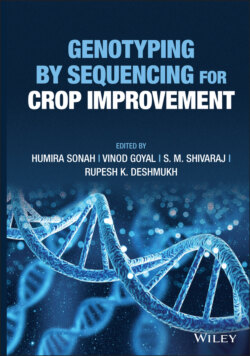Читать книгу Genotyping by Sequencing for Crop Improvement - Группа авторов - Страница 24
1.4 Sequencing‐based Markers 1.4.1 Single‐Nucleotide Polymorphisms (SNPs)
ОглавлениеSingle‐nucleotide polymorphisms (SNPs) are more abundant resulted from single‐base pair variations. These are evenly distributed in a whole genome that can tag almost any gene or locus of a genome (Brookes 1999). However, the distribution of SNPs varies among species with 1 SNP per 60–120 bp in maize (Ching et al. 2002) and 1 SNP per 1000 bp in humans (Sachidanandam et al. 2001). SNPs are more prevalent in the noncoding region. In the coding region, SNPs could be synonymous or nonsynonymous. In synonymous SNPs, there is no change in the amino acid resulting in no phenotypic differences. However, phenotypic differences could be produced due to modified mRNA splicing (Richard and Beckman 1995). In nonsynonymous SNPs, change in amino acid results in phenotypic differences. SNPs are mostly bi‐allelic and cause polymorphism due to nucleotide base substitution. The two types of nucleotide base substitutions result in SNPs. A transition substitution occurs between purines (A, G) or between pyrimidines (C, T). This type of substitution constitutes two‐thirds of all SNPs. A transversion substitution occurs between a purine and pyrimidine. SNPs can be detected by the alignment of the similar genomic region of two different species. The SNPs have only two alleles compared to typical multiallele SSLP; however, this disadvantage can be compensated by using the high density of SNPs.
